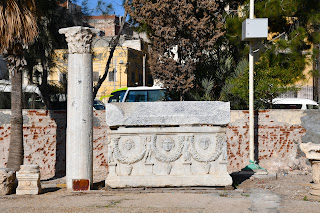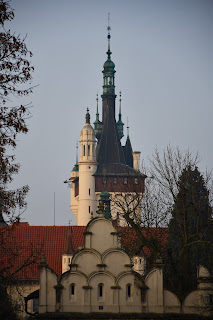An Egyptian Excursion – Day 6: Alexandria
Today I went on a day trip to Alexandria, which I reserved online a few days ago. I was picked up at seven in the morning at my hotel in Cairo and returned almost exactly twelve hours later at the same. Despite sending a message to the tour agency to alert them that there were several hotels with the same name and despite showing them my hotel on a map, the driver still arrived at the wrong one. He was a competent man, so I assume my message was simply never passed on to him. He also had a quite eclectic taste in music: we started the day with some instrumental Egyptian pieces and then transitioned to Armenian pop.
The drive
to Alexandria took around three hours. On the way, we made only one brief stop during
which I fed bits of my croissant to a hungry cat and her kitten. It was the
first food I managed to procure as breakfast at my hotel is only served at
eight. I do not know whether pastries are good for cats, but they were very
persistent, and I trusted their judgement. I met my guide at the Catacombs of
Kom el Shoqafa. She was a tiny young woman with a brain full of facts about
Alexandria. I later inquired into her professional life; she said the reason
why she knows so much is that the process for obtaining a tour guide license is
very strict. Aspiring tour guides typically earn a degree in the subject,
learning a good deal about Egypt’s vast history in addition to one or two
languages. They then have to pass a government exam as well as an intimidating
interview with the Tour Guides Syndicate.
My tour guide showed me the ways in which the Catacombs,
founded around the second century CE, fused Egyptian funerary artwork with the
Greco-Roman tradition. For instance, the entrance to one of the main tombs
featured a Greek pediment decorated with Egyptian-style falcons. Above the
ground, another tomb displayed murals of Egyptian gods painted in European
style, drawing clear distinctions between animals and humans. The underground tombs
are located in chambers that adjoin a deep well-like structure. While the rich
and noble were buried in lavish tombs with plenty of decorations, ordinary
people were laid to rest in very functionalist rows of holes in the walls.
Following the Egyptian tradition, the bodies were mummified, but most of them
were stolen in the Middle Ages and Early Modern Era to satisfy European demand
for medicine made of ground up mummies.
According to the guide, it was previously thought that the
bones of horses found within the catacombs originated from a massacre
orchestrated by Roman Emperor Caracalla. Alexandria had favoured Caracalla’s
brother Geta and reportedly mocked the victorious Caracalla, who avenged
himself by locking the amphitheatre during a game and having everyone murdered
– including the horses. However, it is now thought that the horse bones
belonged to victorious racehorses, as several dedications in the tombs are made
to Nemesis, a goddess associated with fortune.
Driving past the Serapeum with the famous Pillar of Pompey,
we made our way to the Roman Theatre. This name may actually be a
misnomer, as the structure lacks a space for actors to change their costumes,
as well as a dedicated area for musicians. Instead, it was likely an
auditorium: standing on a stone block right in the middle, one can hear strong
echoes even when talking just a little louder than normal speaking volume. The
same complex also contains the ruins of Roman baths (which even had their own
library) and several villas. The area of the villas was never fully unearthed
because the site is now home to several important buildings including a fire
station.
Next, we headed to the Bibliotheca Alexandrina, a modern
incarnation of the Library of Alexandria. The ancient library was partly
destroyed during Caesar’s Civil War of 48 BCE and apparently dwindled in size
since then, though it is unclear which cataclysm delivered the final blow. The
modern Bibliotheca Alexandrina was born out of an international initiative
dating to the 1970s, with a design chosen through an architectural competition
in 1988. Completed in 2002, the library is intelligently built, with slit-like
windows letting in just the right amount of sunlight, and with enough
separation between reading areas and tourist spaces. One interesting feature on
the outside of this complex is its elevated walkway, which was supposed to
reach the sea but was never completed because a military complex was in the
way.
I was surprised at how easy it was to find vegetarian food
for lunch, though I suspect it might have been a different story without an
Arabic-speaking guide translating the menu for me. I had two types of foul and
a baba ghanoush with the local flatbread, all of which I thoroughly enjoyed.
Another thing that surprised me was the choice of music at this very local,
though reasonably upscale place: the order of the day included variations on
Joaquín Rodrigo’s Concierto
de Aranjuez. It reminded me of the fact that Alexandria used to be a very
cosmopolitan city before the rule of Gamal Abdel Nasser. My guide told me that
among his radical reforms, Nasser prohibited foreign nationals from working in federal
jobs and banned them from studying at public universities, which encouraged
non-Egyptian students to return to the lands of their ancestors for their
higher education. The Alexandria of Constantinos Cavafy, I was disheartened to
see in its homogeneous streets, has been lost forever.
Our penultimate stop was the Qaitbay Citadel, a fortress
overlooking Alexandria’s eastern harbour. The citadel stands on what used to be
an island that Alexander the Great connected to the mainland. Famously, the
former island was once home to the great Lighthouse of Alexandria, whose
remains were incorporated into the citadel after several waves of destruction.
The current structure was built by Egypt’s Mamluk rulers to serve as a first
line of defence against a possible naval invasion of Cairo. Ironically, when
the Ottomans did invade Cairo, they did so by passing through Syria.
Finally, we made a quick stop by the Sidi Morsi Abu al-Abbas Mosque, which was built in the twentieth century by an Italian architect but whose history reaches all the way back to the grave of a thirteenth-century mystic. I was particularly taken in by its harmonious pastel colour scheme.





















Comments
Post a Comment